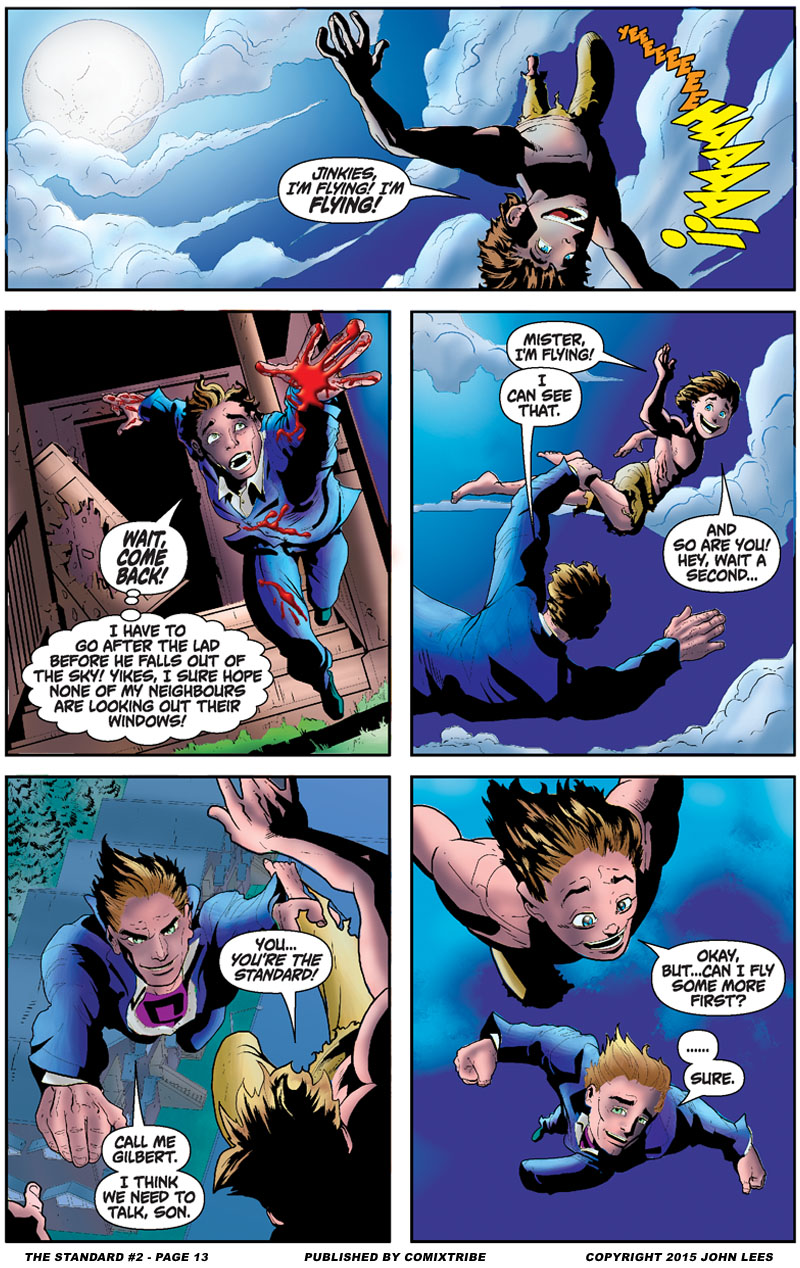The Standard #2 – Page 13
Back to flashback mode again here. Jon Rector admirably captures the euphoria of flight in the facial expressions here. I also particularly like the cool blue aesthetic Gulliver Vianei brought to the colours here.
And while we’re looking at the beginnings of Alex Thomas as a superhero, it seems like a good point to look back at the fictional history of the man he would become:
The Standard as Celebrity
I’m sure it will come as little surprise to inform you that, in the wake of The Standard’s public unmasking, Alex Thomas found himself the owner of the most famous face in the world. Up until this point, he had successfully maintained an alter ego, much like Gilbert Graham before him. He’d gone through high school and college, and worked part time at a grocery store. He had a normal life to balance with his life as The Standard, to keep him grounded. But in one moment, that normality was gone, and Alex had committed himself to being seen – at all times and forever – as The Standard.
First came a vast string of newspaper and magazine interviews and talk show appearances. Here, Alex played coy with his early life, but talked a lot about his time as Fabu-Lad and what becoming The Standard meant to him. What was immediately clear was that he would be a very different Standard to Gilbert Graham. Of course, the concept of a publicly-known identity wasn’t new for superheroes. But it was new for The Standard, and being that he was the first, whatever path The Standard takes has always seemed to dictate the dominant trend of superheroes as a whole. Here, we were seeing the transformation of The Standard from masked crime-fighter to celebrity, and the effect this had on superheroes as a whole will be discussed in more depth in the weeks to come.
The Standard was soon asked to lend his likeness to a multitude of advertisements, and a whole new wave of Standard-mania was underway. Suddenly, it seemed Alex Thomas’s grinning face was everywhere you looked: in the newspaper, on the TV, on giant billboards all over every city. Sponsorship deals were worked out with various companies – most prominently, in an ironic turn, international technology conglomerate Zarthos Industries – and their logos soon adorned The Standard’s costume, turning him into a moving, flying advertisement himself. With the backing of Zena Zarthos’s powerhouse legal team, Alex also got a hefty cut of profits on all officially licensed Standard merchandise: T-shirts, action figures, calendars, and other assorted memorabilia. Before long, Alex found himself a very rich man, and this was just the beginning.
This continued on for a few years, with The Standard balancing his crime-fighting duties with public appearances and new advertising and merchandising deals. But the true seismic shift came at the turn of the 21st century, with the launch of The Standard on the Hawks Network. The Standard, along with the likes of Survivor and Big Brother, marked the dawn of the boom in reality television as the new network ratings giant. The hour-long weekly show features a camera crew following The Standard around as he fights crime and does his hero duties. Due to their aforementioned decline, supervillains showing up to do battle with The Standard was a comparatively rare occurrence, and in notable occasions where they did – such as the season-long Season 3 storyline where Alex engaged in a romantic relationship with hairdresser Stacey Farrell, only for her to be exposed as man-killing villainess the Penis Flytrap – it was at one point rumored that the villains were paid for their participation by the network. More recent seasons have increasingly drifted away from crime-fighting altogether, focusing more on The Standard’s personal life and charity work.
This was a massive hit for many years and, now in its 12th season, remains popular to this day. But a few years later The Standard spearheaded another reality TV concept that could stand as his biggest money-maker yet. Hero Watch plays like an American Idol or America’s Next Top Model for superheroes, with thousands of hopefuls being whittled down to a selection of 12 finalists, personally mentored by The Standard, with the public voting each week to narrow the group down until just one remains. That winner gets to join The Standard’s superhero team The Trailblazers, with luxury accommodation and a base of operation in the famous Treehouse of Heroes. As far as I can tell, none of the competition winners seem to engage in any major crime-fighting, and winning seems to just pave the way for merchandising and sponsorship deals, public appearances, and a spot in The Trailblazers, who have their own high-profile reality TV show.
With the Hero Watch brand being shopped out and adapted to countries all over the world, as well as the American original being a huge international hit, The Standard is now often dubbed “The Simon Cowell of superheroes”. He is the face at the centre of a media empire, with two massively successful television brands under his belt. He’s gone from a millionaire to a billionaire, but interestingly, while he does own a country mansion, he spends most of his time in his apartment in the heart of Sky City. “The city’s in my blood now,” he explained when once asked about this in an interview, “I just can’t sleep anywhere else.”
Alex Thomas is now the most famous man on the planet. And his fame seems set to continue to grow. His recently released autobiography, My Life in Tights, is an international number-one bestseller, and is said to be the basis for the upcoming film biopic about The Standard’s life, with Alex Thomas playing himself in the movie.
So, life has been good to Alex Thomas, and he is enjoying success. Still, I can’t help feeling a bit sad. With all these business ventures and projects in the entertainment industry – and admittedly numerous charity endeavours, which is highly commendable – it seems like these days The Standard doesn’t have much time to actually fight crime and save lives anymore. Today, The Standard still inspires people, but does he do so the way Gilbert Graham originally intended?







Discussion ¬